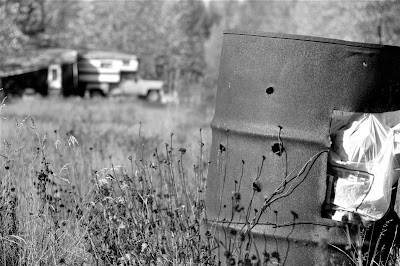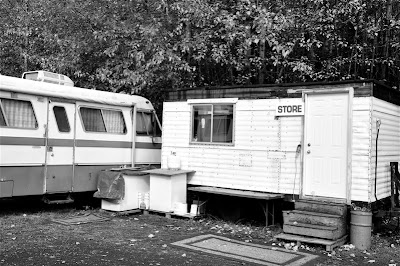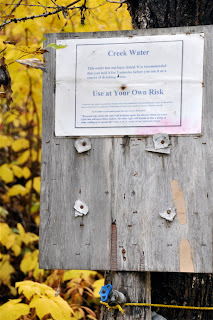In late September, with my friend Beedle (of Fat of the Land fame) at the wheel, I rode shotgun on a long drive up to northwest British Columbia to go steelheading (more on that in a future post). We camped on the banks of the Kispiox, tributary to the Skeena, and sure enough the first big rainstorm of the season blew out the entire system just a few days after our arrival. So much for fishing.
Instead we took advantage of river out and explored the enormous country that is backwoods B.C., with an eye out for the mushroom trade that is such an integral part of this region.
In the hamlet of Kitwanga, just off highway 37 (only 700 miles to Alaska!), we found a buyer named Ave. He had his buy station—a simple wall tent with a wood stove—set up on a friend’s gravel lot just outside of town. As we pulled in Ave was in the middle of telling two First Nations men how they might go about finding mushrooms to sell. Otherwise the place looked deserted. It’s been a poor year for the matsutake harvest in B.C., with a record drought for most of the summer and early fall. We were told the Kispiox was as as low as it had been since river levels were first recorded, 70 years ago.

Meanwhile, with ample September rains, Oregon and Washington are enjoying a good year (recreational hunters might call it spectacular, while commercial hunters are happy that it’s finally underway after a slow start in August) and the matsutake harvest in places like Crescent Lake is bountiful enough that prices paid to pickers in Canada are as low as $3/lb. Ave figured he’d have a bunch of pickers pulling in later in the afternoon with mushrooms to sell but he wasn’t too enthusiastic about the season so far. In a few weeks he planned to head south to Vancouver Island to buy chanterelles, and then on to southern Oregon and northern California for the black trumpet pick come winter.
After lunch at the excellent Kitwanga Diner, we went north on 37 to … don’t blink or you’ll miss it … Cranberry Junction, where an infamous ad hoc mushroom camp has existed for years.
Known affectionately (or frighteningly, depending on your disposition) as “The Zoo,” this place has hosted as many as 1,500 mushroom pickers during the go-go years when matsutake fetched exorbitant prices on the Japanese market and pickers stuffed their pockets with cash for mushrooms. Now, after several so-so harvests and prices in the tank, it was nearly a ghost town. We saw only a handful of campers who had erected various forms of habitation, from simple tarp-and-stringer tents to more elaborate school-bus shacks.



The only one around was Grace, who has run the mobile general store here for the last decade. Grace had never seen the camp so desolate and she didn’t expect it to get any better with the recent rain. At $3 per pound, there’s little incentive—even poverty, it would seem—for a picker to hump mushrooms out of the bush all day. Grace explained that expenses (e.g., gas, food, auto repairs) can be as much as $100 a day, meaning 50 pounds of matsutake hardly covers your overhead. And on a year like this, picking 100 pounds a day is only feasible for the most knowledgeable of pickers.


Grace’s two football-sized dogs yapped away and she finally had to go back inside her trailer to nurse an illness. We were left alone in a nearly empty camp with a few indelible images: an outhouse in splinters on the ground, as if overrun by grizzlies; a burned out car that might have once been used as shelter more than transportation; a rusted and bullet-riddled trash-can spilling its refuse; a ruined tent slumping in the wind.
Images such as these might make you think about your next purchase of wild mushrooms at the local grocery store or farmers market. And by think I don’t mean to suggest you not buy them, only that you consider the supply chain that brings us these wild delicacies. The other day I saw porcini advertised for $40/lb and chanterelles at $15/lb. Even birch boletes, not nearly as choice as king boletes, were commanding a hefty $30/lb price-tag.
I’m not sure what the answer is. An astute commenter on one of my earlier posts noted that the inequities in the wild mushroom business are no different than in any other industry in America; wherever you look, those on the lower rungs are compensated proportionately less than those on top, yet without those people there is no top. As a recreational hunter, I can tell you that the knowledge, physical ability, and sheer cojones required to harvest large quantities of wild mushrooms in the wilderness are substantial. As a consumer and restaurant patron, I can tell you that the costs of eating these delicacies are dear. And as a member of the human race, I can tell you there are other hidden societal costs of not valuing the skills that put these foods on our plates. What are those costs worth?
Like this:
Like Loading...
 I had the pleasure of sitting down recently with Eric Parkinson, of This Must Be the Place, a podcast that seeks to reveal “the unique physical, cultural, and emotional layers of places.”
I had the pleasure of sitting down recently with Eric Parkinson, of This Must Be the Place, a podcast that seeks to reveal “the unique physical, cultural, and emotional layers of places.”























